|
(
St. Agatha and Catania )
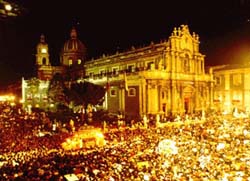
Three
days of cult, devotion, folklore, and tradition, that stand
almost alone in the world.
Only
the Holy Week in Seville, and the corpus Domini ceremony
in Cuzco, Peru, may be compared in terms of popularity,
to the festivities that since five centuries bave immutably
been held in St. Agatha's honour. For three days, Catanians
and tourists swarm in the streets, numbering to almost a
million. During those intense days, Catania turns into one
and only crowd marching behind the Patron.
(
Three incredible days )
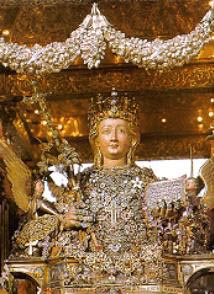 The
4th and 5th of February stand out among the three days of
festivities, when St. Agatha passes through then eigh bourhoods
on her silver carriage (Catanians call it, specifically,
"fercolo" or, more commonly, "vara"). The
4th and 5th of February stand out among the three days of
festivities, when St. Agatha passes through then eigh bourhoods
on her silver carriage (Catanians call it, specifically,
"fercolo" or, more commonly, "vara").
The
first day of celebration, the 3th of February, develops
itself into three distinct moments: the long and solemn
Midday procession for "the offering of wax" to which civil,
religious and militar authorities all attend bearing the
standards of the City, the Province, and the University.
Leaving St. Agatha' s (the Church of St. Agata alla Fornace
) to the Cathedral, the procession cuts through two lines
of a huge crowd. Eleven "candelore" (large candleshaped
structures), symbolizing the guilds, and two carriages belonging
to the old Catanian Senate, bring up the rear. In the afternoon,
at 3.00 PM, St. Agatha's international cross-country race
takes place through the old and new streets of the town-centre.
Finally, in the evening, later than 8.00 PM, grandious fireworks
are on display in piazza Duomo.
 The
following night is spent sleepless by tbousands of Catanians,
who crowd the Cathedral at dawn in a strongly emotional
atmosphere, for a first meeting with "their" Saint. St.
Agatha's image, waving amidst the crowd, is firstly brought
to the high altar, than on the "vara" by devotees wearing
the "sacco" (a white alb): its bust, covered up with jewels
bestowed by sovereigns and celebrities (there also is a
cross wbich was donated by composer Vincenzo Bellini), rises
and falls amidst a cheering crowd. The
following night is spent sleepless by tbousands of Catanians,
who crowd the Cathedral at dawn in a strongly emotional
atmosphere, for a first meeting with "their" Saint. St.
Agatha's image, waving amidst the crowd, is firstly brought
to the high altar, than on the "vara" by devotees wearing
the "sacco" (a white alb): its bust, covered up with jewels
bestowed by sovereigns and celebrities (there also is a
cross wbich was donated by composer Vincenzo Bellini), rises
and falls amidst a cheering crowd.
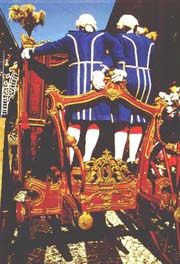 The
carriage carrying the reliquary-bust and the finely wrought
silver casket containing other relics, starts covering the
route crossing through Porta Uzeda, then passing through
via Dusmet, the distinctive feature of which are the arches
holding up the railway: beneath them, once there was the
sea, just close to via Biscari, where St. Agatha supposedly
was born. The route from piazza Carlo Alberto to piazza
Stesicoro is eagerly awaited: we are now in places tbat
are extremely dear to Catanians; in these ancient sites,
Agatha men with imprisonment and martyrdom, dying in atrocious
sufferings. There, it is anotber spectacular moment: thousands
of devotes run and drag the heavy carriage along a slope
(salita dei Cappuccini), stopping once halfway to pay homage
to the Sacred Gaol. The
carriage carrying the reliquary-bust and the finely wrought
silver casket containing other relics, starts covering the
route crossing through Porta Uzeda, then passing through
via Dusmet, the distinctive feature of which are the arches
holding up the railway: beneath them, once there was the
sea, just close to via Biscari, where St. Agatha supposedly
was born. The route from piazza Carlo Alberto to piazza
Stesicoro is eagerly awaited: we are now in places tbat
are extremely dear to Catanians; in these ancient sites,
Agatha men with imprisonment and martyrdom, dying in atrocious
sufferings. There, it is anotber spectacular moment: thousands
of devotes run and drag the heavy carriage along a slope
(salita dei Cappuccini), stopping once halfway to pay homage
to the Sacred Gaol.
 In
the evening, the run takes place downtown: via Plebiscito,
Fortino, S. Cristoforo. There the festivities are felt in
a different way: all private houses are open and well-lit,
coffee-houses are crowded all night long. Music is heard
coming from everywhere, Streets are crowded with stalls
and booths where all sorts of sweets are sold, and mobile
grids where horse meat is roasted. Balconies are well-lit,
kiosks are strewn with flowers and embellisbed with St.
Agatha's effigy, while shop-windows display artistic reproductions
of the "candelore". Almost at dawn, magnificent fireworks
welcome the Saint on her way back to the Cathedral passing
through Porta Uzeda again. In
the evening, the run takes place downtown: via Plebiscito,
Fortino, S. Cristoforo. There the festivities are felt in
a different way: all private houses are open and well-lit,
coffee-houses are crowded all night long. Music is heard
coming from everywhere, Streets are crowded with stalls
and booths where all sorts of sweets are sold, and mobile
grids where horse meat is roasted. Balconies are well-lit,
kiosks are strewn with flowers and embellisbed with St.
Agatha's effigy, while shop-windows display artistic reproductions
of the "candelore". Almost at dawn, magnificent fireworks
welcome the Saint on her way back to the Cathedral passing
through Porta Uzeda again.
(
Spectacle and devotion )
Just
few hours of sleep: in the late morning of the 5th. of February
(the climax of the festivity), a Pontifical Mass is celebrated
by a specially invited prelate.
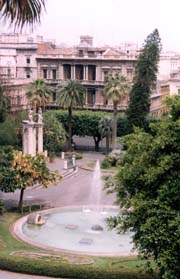 The
Saint's image travels along another route, through the old
town centre: the carriage proceeds slowly along the elegant
via Etnea. The eleven, richly adorned "candelore" lead the
procession, being followed by 700 devotees holding torches:
then the white river of devotees follows. They all drag
the "vara" and sing the praises of the Patron ("We are all,
all devotees. Citizens, long live St. Agatha!"). The City
bell tolls, announcing the Mayor's homage to the Saint.
The stream of people puts on a protracted and fascinating
tableau vivant. In the evening, people crowd together again
in piazza Borgo, in order to attend further fireworks (also
known as "the fireworks of the evening of three"); soon
after the crowd follows and escorts the "candelore" in an
"endurance race" along the slope of "salita di San Giuliano".
Time goes by, and the setting sun gives way to the night:
St. Agatha patiently awaits for the end of the contest,
at the crossing of via Etnea and via di San Giuliano: it's
the "final pull", that should bring the festivity to an
end, with an enthusiastic applause of relief. The race is
an event mostly reserved to young people: strong arms and
sturdy legs are needed to drag the several tons of the "vara".
Partaking to the race is a mark of love and devotion that
should non be underrated: doing it in "one go" allows to
draw favorable auspicies for the year, since the real New
Years Day in Catania falls on the 5th of February; once,
contracts and deeds were actually started or delivered on
such a date. The
Saint's image travels along another route, through the old
town centre: the carriage proceeds slowly along the elegant
via Etnea. The eleven, richly adorned "candelore" lead the
procession, being followed by 700 devotees holding torches:
then the white river of devotees follows. They all drag
the "vara" and sing the praises of the Patron ("We are all,
all devotees. Citizens, long live St. Agatha!"). The City
bell tolls, announcing the Mayor's homage to the Saint.
The stream of people puts on a protracted and fascinating
tableau vivant. In the evening, people crowd together again
in piazza Borgo, in order to attend further fireworks (also
known as "the fireworks of the evening of three"); soon
after the crowd follows and escorts the "candelore" in an
"endurance race" along the slope of "salita di San Giuliano".
Time goes by, and the setting sun gives way to the night:
St. Agatha patiently awaits for the end of the contest,
at the crossing of via Etnea and via di San Giuliano: it's
the "final pull", that should bring the festivity to an
end, with an enthusiastic applause of relief. The race is
an event mostly reserved to young people: strong arms and
sturdy legs are needed to drag the several tons of the "vara".
Partaking to the race is a mark of love and devotion that
should non be underrated: doing it in "one go" allows to
draw favorable auspicies for the year, since the real New
Years Day in Catania falls on the 5th of February; once,
contracts and deeds were actually started or delivered on
such a date.
(
Martyrdom and the old town )
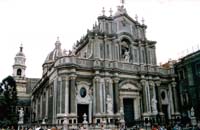 Catania,
brought back to life after every eruption of the Etna volcano,
has bestowed some of the most beautiful churches and monuments
to the Patron. On the inside of "S. Agata al Carcere", the
III century remains of the gaol, where St. Agatha faced
her martyrdom and death, are still to be seen. The Church
of "S. Agata alla Fornace" (in piazza stesicoro) and "S.
Agata la Vetere" (the first Cathedral of Catania, and supposedly
the first burial-place of the Saint) are non far. Many other
places in Catania keep alive the memory of St. Agatha: "Badia
S. Agata", the "stele" in piazza dei Martiri, the fountain
in via Dusmet, the Norman-baroque Cathedral. Catania,
brought back to life after every eruption of the Etna volcano,
has bestowed some of the most beautiful churches and monuments
to the Patron. On the inside of "S. Agata al Carcere", the
III century remains of the gaol, where St. Agatha faced
her martyrdom and death, are still to be seen. The Church
of "S. Agata alla Fornace" (in piazza stesicoro) and "S.
Agata la Vetere" (the first Cathedral of Catania, and supposedly
the first burial-place of the Saint) are non far. Many other
places in Catania keep alive the memory of St. Agatha: "Badia
S. Agata", the "stele" in piazza dei Martiri, the fountain
in via Dusmet, the Norman-baroque Cathedral.
Precious
relics, as such as the bust and the casket bearing the signature
of Di Bartolo, are preserved in the Basilica, but the real
centre of the cult of St. Agatha is the Church of the Sacred
Gaol. On the inside, besides the dark cell where the Saint
was imprisoned, a lavic slabbearing St. Agatha's footprints
can be seen. The prison, an embankment, was part of the
buildings of the Roman praetorium, close to the residence
of Quintianus, Agatha's persecutor. Upon the high altar,
a large panel dating back to 1588 and bearing Bernardino
Niger's signature, portras St. Agatha at the stake. Next
to the Gaol, a highly revered lavic stone bears St. Agatha's
footprints. A plaque of the XV century and portraying St.
Agatha can be seen in the sacristy, besides memorial stones,
bas-reliefs and an old epigraph: "Noli offendere patriam
Aghatae, quia ultrix iniuratum est" (Do not offend Agatha's
nation, "cause she will avenge all offence).
(
Candlemas, a baroque feast )
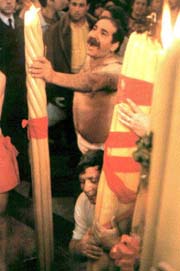
"Almost
all Sicilian feasts are baroque" says historian Giovanni
Lanzafame. Writing about the eleven "candelore", he defines
the so called "annacata " as "baroque on the move ". Baroque
moving through a baroque city as devised by Vaccarini after
the 1693 earthquake.
Ten
huge "candelore" and a smaller one, now lead the procession.
A candelabrum in memory of cardinal Ventimiglia comes first,
being followed by the "candelora" (decorated with four griffins
at the basement) offered by the inhabitants of San Giuseppe
La Rena. Then the candelabrum of the Floriculturists follows,
in Gothic style, portraying statues of Catanian martyrs
and bishops: once it was tooped with a bouquet of flowers,
now replaced by a bow.
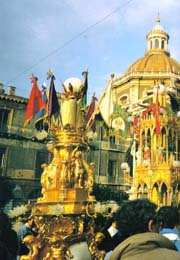 The
"candelora " representing Fishmongers comes next: it is
in rococo style and bears votive offerings and a statue
of St. Francis of Paola, patron
of fisbermen and sailors. The other "candelore" represent
Greengrocers (it bears a bust of St. Agatha), Butchers (it
displays a small bouquet of flowers), Makers of Pasta (an
eighteenth-century candlestick), Grocers (in liberty style,
decorated with characteristic caryatids at the basement),
Bakers (the heaviest, carried by twelve people, instead
of eight, and displaying human-heigbt statues of angels),
Vintners (carried by ten people and displaying four lions
and griffins at the basement). The
"candelora " representing Fishmongers comes next: it is
in rococo style and bears votive offerings and a statue
of St. Francis of Paola, patron
of fisbermen and sailors. The other "candelore" represent
Greengrocers (it bears a bust of St. Agatha), Butchers (it
displays a small bouquet of flowers), Makers of Pasta (an
eighteenth-century candlestick), Grocers (in liberty style,
decorated with characteristic caryatids at the basement),
Bakers (the heaviest, carried by twelve people, instead
of eight, and displaying human-heigbt statues of angels),
Vintners (carried by ten people and displaying four lions
and griffins at the basement).
(
An international cult )
The
cult of St. Agatha is non strictly Catanian: the Saint is
venerated all over the world. St. Agatha is the Patron of
44 italian municipalities, and 14 of them bear her name.
Besides, St. Agatha is among the Patrons of Malta and S.
Marino. In Spain, she is worshipped in Andalucia and in
Jèria (Valencia). The chapel in Barcelona where the Catholic
sovereigns welcomed Christopher Columbus back from his first
trip to America, is dedicated to St. Agatha. A peculiar
tradition takes place in Zamarramal (Segovia): on the 5th
of February, women are the masters of the city. In Portugal,
St. Agatha is the Patron of Agueda. In Germany Agatha is
the Patron of Aschaffemburg. In France, St. Agatha is venerated
in Le Fournet (Normandy). The cult was grandiosely celebrated
in Costantinople, while in Greece the Saint is extremely
popular, specially in the Aetolian region. Even in India,
in Viayawala, a cult of St. Agatha exists, and in Argentina,
where sbe is the Patron of firemen. The cult is widely spread
in Italy, specially in Lombardia, but also in Rome, Florence
and Naples.
(
Art and St. Agatha )
Works
of art honoring St. Agatha are spread all over the world:
in Ukraine (in Kiev), Italy (in Ravenna, Uffizi Museum and
Galleria Pitti in Florence), Austria, Malta, and Spain.
In
most of Catanian private houses and in those churches where
the Saint is officially venerated, busts of St. Agatha are
easy to be faund.
The
whole province of Catania is rich with works of art dedicated
to such a cult: the most famous of them is in Nicolosi,
where Cardinal Dusmet saved the city using the veil of St.
Agatha to stop lava flows.
|

 The
4th and 5th of February stand out among the three days of
festivities, when St. Agatha passes through then eigh bourhoods
on her silver carriage (Catanians call it, specifically,
"fercolo" or, more commonly, "vara").
The
4th and 5th of February stand out among the three days of
festivities, when St. Agatha passes through then eigh bourhoods
on her silver carriage (Catanians call it, specifically,
"fercolo" or, more commonly, "vara").  The
following night is spent sleepless by tbousands of Catanians,
who crowd the Cathedral at dawn in a strongly emotional
atmosphere, for a first meeting with "their" Saint. St.
Agatha's image, waving amidst the crowd, is firstly brought
to the high altar, than on the "vara" by devotees wearing
the "sacco" (a white alb): its bust, covered up with jewels
bestowed by sovereigns and celebrities (there also is a
cross wbich was donated by composer Vincenzo Bellini), rises
and falls amidst a cheering crowd.
The
following night is spent sleepless by tbousands of Catanians,
who crowd the Cathedral at dawn in a strongly emotional
atmosphere, for a first meeting with "their" Saint. St.
Agatha's image, waving amidst the crowd, is firstly brought
to the high altar, than on the "vara" by devotees wearing
the "sacco" (a white alb): its bust, covered up with jewels
bestowed by sovereigns and celebrities (there also is a
cross wbich was donated by composer Vincenzo Bellini), rises
and falls amidst a cheering crowd.  The
carriage carrying the reliquary-bust and the finely wrought
silver casket containing other relics, starts covering the
route crossing through Porta Uzeda, then passing through
via Dusmet, the distinctive feature of which are the arches
holding up the railway: beneath them, once there was the
sea, just close to via Biscari, where St. Agatha supposedly
was born. The route from piazza Carlo Alberto to piazza
Stesicoro is eagerly awaited: we are now in places tbat
are extremely dear to Catanians; in these ancient sites,
Agatha men with imprisonment and martyrdom, dying in atrocious
sufferings. There, it is anotber spectacular moment: thousands
of devotes run and drag the heavy carriage along a slope
(salita dei Cappuccini), stopping once halfway to pay homage
to the Sacred Gaol.
The
carriage carrying the reliquary-bust and the finely wrought
silver casket containing other relics, starts covering the
route crossing through Porta Uzeda, then passing through
via Dusmet, the distinctive feature of which are the arches
holding up the railway: beneath them, once there was the
sea, just close to via Biscari, where St. Agatha supposedly
was born. The route from piazza Carlo Alberto to piazza
Stesicoro is eagerly awaited: we are now in places tbat
are extremely dear to Catanians; in these ancient sites,
Agatha men with imprisonment and martyrdom, dying in atrocious
sufferings. There, it is anotber spectacular moment: thousands
of devotes run and drag the heavy carriage along a slope
(salita dei Cappuccini), stopping once halfway to pay homage
to the Sacred Gaol.  In
the evening, the run takes place downtown: via Plebiscito,
Fortino, S. Cristoforo. There the festivities are felt in
a different way: all private houses are open and well-lit,
coffee-houses are crowded all night long. Music is heard
coming from everywhere, Streets are crowded with stalls
and booths where all sorts of sweets are sold, and mobile
grids where horse meat is roasted. Balconies are well-lit,
kiosks are strewn with flowers and embellisbed with St.
Agatha's effigy, while shop-windows display artistic reproductions
of the "candelore". Almost at dawn, magnificent fireworks
welcome the Saint on her way back to the Cathedral passing
through Porta Uzeda again.
In
the evening, the run takes place downtown: via Plebiscito,
Fortino, S. Cristoforo. There the festivities are felt in
a different way: all private houses are open and well-lit,
coffee-houses are crowded all night long. Music is heard
coming from everywhere, Streets are crowded with stalls
and booths where all sorts of sweets are sold, and mobile
grids where horse meat is roasted. Balconies are well-lit,
kiosks are strewn with flowers and embellisbed with St.
Agatha's effigy, while shop-windows display artistic reproductions
of the "candelore". Almost at dawn, magnificent fireworks
welcome the Saint on her way back to the Cathedral passing
through Porta Uzeda again. The
Saint's image travels along another route, through the old
town centre: the carriage proceeds slowly along the elegant
via Etnea. The eleven, richly adorned "candelore" lead the
procession, being followed by 700 devotees holding torches:
then the white river of devotees follows. They all drag
the "vara" and sing the praises of the Patron ("We are all,
all devotees. Citizens, long live St. Agatha!"). The City
bell tolls, announcing the Mayor's homage to the Saint.
The stream of people puts on a protracted and fascinating
tableau vivant. In the evening, people crowd together again
in piazza Borgo, in order to attend further fireworks (also
known as "the fireworks of the evening of three"); soon
after the crowd follows and escorts the "candelore" in an
"endurance race" along the slope of "salita di San Giuliano".
Time goes by, and the setting sun gives way to the night:
St. Agatha patiently awaits for the end of the contest,
at the crossing of via Etnea and via di San Giuliano: it's
the "final pull", that should bring the festivity to an
end, with an enthusiastic applause of relief. The race is
an event mostly reserved to young people: strong arms and
sturdy legs are needed to drag the several tons of the "vara".
Partaking to the race is a mark of love and devotion that
should non be underrated: doing it in "one go" allows to
draw favorable auspicies for the year, since the real New
Years Day in Catania falls on the 5th of February; once,
contracts and deeds were actually started or delivered on
such a date.
The
Saint's image travels along another route, through the old
town centre: the carriage proceeds slowly along the elegant
via Etnea. The eleven, richly adorned "candelore" lead the
procession, being followed by 700 devotees holding torches:
then the white river of devotees follows. They all drag
the "vara" and sing the praises of the Patron ("We are all,
all devotees. Citizens, long live St. Agatha!"). The City
bell tolls, announcing the Mayor's homage to the Saint.
The stream of people puts on a protracted and fascinating
tableau vivant. In the evening, people crowd together again
in piazza Borgo, in order to attend further fireworks (also
known as "the fireworks of the evening of three"); soon
after the crowd follows and escorts the "candelore" in an
"endurance race" along the slope of "salita di San Giuliano".
Time goes by, and the setting sun gives way to the night:
St. Agatha patiently awaits for the end of the contest,
at the crossing of via Etnea and via di San Giuliano: it's
the "final pull", that should bring the festivity to an
end, with an enthusiastic applause of relief. The race is
an event mostly reserved to young people: strong arms and
sturdy legs are needed to drag the several tons of the "vara".
Partaking to the race is a mark of love and devotion that
should non be underrated: doing it in "one go" allows to
draw favorable auspicies for the year, since the real New
Years Day in Catania falls on the 5th of February; once,
contracts and deeds were actually started or delivered on
such a date. Catania,
brought back to life after every eruption of the Etna volcano,
has bestowed some of the most beautiful churches and monuments
to the Patron. On the inside of "S. Agata al Carcere", the
III century remains of the gaol, where St. Agatha faced
her martyrdom and death, are still to be seen. The Church
of "S. Agata alla Fornace" (in piazza stesicoro) and "S.
Agata la Vetere" (the first Cathedral of Catania, and supposedly
the first burial-place of the Saint) are non far. Many other
places in Catania keep alive the memory of St. Agatha: "Badia
S. Agata", the "stele" in piazza dei Martiri, the fountain
in via Dusmet, the Norman-baroque Cathedral.
Catania,
brought back to life after every eruption of the Etna volcano,
has bestowed some of the most beautiful churches and monuments
to the Patron. On the inside of "S. Agata al Carcere", the
III century remains of the gaol, where St. Agatha faced
her martyrdom and death, are still to be seen. The Church
of "S. Agata alla Fornace" (in piazza stesicoro) and "S.
Agata la Vetere" (the first Cathedral of Catania, and supposedly
the first burial-place of the Saint) are non far. Many other
places in Catania keep alive the memory of St. Agatha: "Badia
S. Agata", the "stele" in piazza dei Martiri, the fountain
in via Dusmet, the Norman-baroque Cathedral. 
 The
"candelora " representing Fishmongers comes next: it is
in rococo style and bears votive offerings and a statue
of St. Francis of Paola, patron
of fisbermen and sailors. The other "candelore" represent
Greengrocers (it bears a bust of St. Agatha), Butchers (it
displays a small bouquet of flowers), Makers of Pasta (an
eighteenth-century candlestick), Grocers (in liberty style,
decorated with characteristic caryatids at the basement),
Bakers (the heaviest, carried by twelve people, instead
of eight, and displaying human-heigbt statues of angels),
Vintners (carried by ten people and displaying four lions
and griffins at the basement).
The
"candelora " representing Fishmongers comes next: it is
in rococo style and bears votive offerings and a statue
of St. Francis of Paola, patron
of fisbermen and sailors. The other "candelore" represent
Greengrocers (it bears a bust of St. Agatha), Butchers (it
displays a small bouquet of flowers), Makers of Pasta (an
eighteenth-century candlestick), Grocers (in liberty style,
decorated with characteristic caryatids at the basement),
Bakers (the heaviest, carried by twelve people, instead
of eight, and displaying human-heigbt statues of angels),
Vintners (carried by ten people and displaying four lions
and griffins at the basement). 
